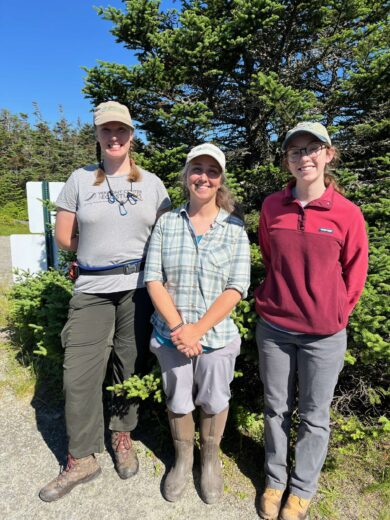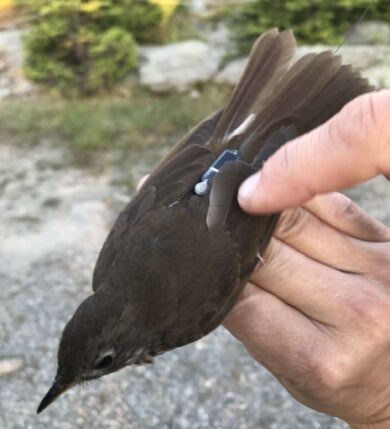
VCE’s 2024 Mt. Mansfield team, left to right: Anna Peel, Dr. Desirée Narango, and Zoey Pickett
We have been writing a lot lately about VCE’s work on pollinators, especially wild bees and butterflies. (Rightly so—the culmination of our years-long Wild Bee research has yielded significant conservation activity, in Vermont and across the nation. And the start of VCE’s latest statewide wildlife atlas, the 2nd Vermont Butterfly Atlas, will reveal how populations of Vermont’s butterflies have changed in the 20 years since the 1st Vermont Butterfly Atlas was completed.)
With all the buzz (sorry) on bees and other pollinators, you may be wondering if VCE is still studying birds. Are we ever! We continue to provide technical assistance to landowners about managing grasslands for birds, especially Bobolinks and the newly-state listed Eastern Meadowlark. We are collaborators on a hemisphere-wide study of Olive-sided Flycatchers with state agencies across the country. We continue (with the nocturnal help of many volunteers) to monitor Eastern Whip-poor-wills and have recently worked with the state to create a recovery plan for this vulnerable species. Of course, the Vermont Loon Conservation Project is going full steam ahead, doubling down on efforts to remove lead tackle from circulation after loon necropsies have shown that contaminant has increased in the last couple of years, all while managing and stewarding a record number of nesting loon pairs with the help of hundreds of volunteers.
This dispatch, though, is about our flagship species, the Bicknell’s Thrush (BITH), and other high-elevation birds found on Mt. Mansfield, Vermont’s highest peak. With Chris Rimmer’s retirement, our newest conservation scientist, Dr. Desirée Narango, took up the Mansfield mantle to continue this rich long-term study. Adding her own research questions and approach to the work, Desirée is continuing the monitoring that Chris started 34 years ago and extending the program to include new collaborators, new ecological questions, the latest tracking technology, and exciting discoveries.
Here’s an update on our high-mountain research in 2024:
Mansfield Ridgeline Research: Main goals for 2024
Attaching solar- and battery- powered Motus tags to female Bicknell’s Thrush on Mt. Mansfield, Mt. Washington, and in the Dominican Republic
These tags, sporting the tiniest solar panel you can imagine, will allow us to assess bird survival over the full annual cycle and to better understand migratory patterns. Most of our data on migration is on males. Unlike previous tags (which were archival—meaning we had to recapture the birds to collect the data– and limited by their battery life), these tags will last for the life of the bird and continuously transmit data to a network of radiotelemetry receivers across the country. This work is funded by the US Forest Service International Program and led by VCE scientists Desirée Narango, Mike Hallworth, and Jim Goetz.
Attaching geolocators to Blackpoll Warblers
The geolocators tags we are using this year are archival tags that collect data on light levels and barometric pressure simultaneously, providing precise data on how high these birds are flying to help evaluate the potential risk offshore wind farms might pose for these birds. This work is a collaboration between, and funded by, National Audubon and VCE. Lead scientists include VCE’s Mike Hallworth and Desirée Narango, along with Bill Deluca from National Audubon Society.
Bird Diets and Long-term Banding
We will use fecal and blood samples from our six focal species to assess the birds’ diet relative to insect availability. We are repeating a study of insects on the Mansfield ridgeline that was conducted by scientists at UVM Extension 30 years ago, following the same protocols, for comparison purposes. Long-term capture-recapture data from the full suite of birds we net and band allows us to assess survival rates across the bird community.
Tagging Technology
We have deployed three different types of tags to track Bicknell’s Thrushes over the years. The first tags, which helped to define the Greater Antilles as the entire scope of BITH wintering grounds, were called light-level geolocators. They were not very precise, but they returned sunrise and sunset times, from which approximate latitude and longitude could be extrapolated. Birds carrying these tags had to be re-caught for us to recover the data they carried.

A Bicknell’s Thrush sports its new solar-powered tag.
Next, as technology improved, we began to use GPS tags. These battery-operated tags were limited in that we could select up to 50 specific times when they would record a very precise location. For example, if we wanted to refine what we know about their wintering habitat and territory size, we would program the fixes in January and February. To recover the data, we had to recapture the birds.
In 2023, we began using Motus tags. (Motus is Latin for movement, and these tags are so named because they are used to track animal movement.) These tags can be detected if the bird flies within about 15 km of a Motus tower. There is a growing network of receiver towers across the world, with the highest density in the eastern United States. When a tagged bird passes by a Motus tower, it records the unique pattern of beeps that tag is emitting and records that individual bird’s presence.
After only one year, our Motus-tagged birds have already revealed tremendous information about our thrushes on both Mt. Mansfield and in the Dominican Republic:
● One receiver on the Georgia coast hosted by the US Fish and Wildlife Service (Lat.: 31.2956°, Lon.: -81.3435) has picked up 16 different individual BITH from our project! This is very exciting, as data on northbound migratory pathways is currently sparse, and threats to Bicknell’s Thrush during migration are poorly understood.
● As for southbound migration, almost all the birds tagged on Mansfield that have been detected were noted by towers in the Mid-Atlantic coast. These data suggest that coastal areas are likely more important for the Bicknell’s Thrush population than previously recognized.
Why It Matters
Perhaps you are wondering what the goal of all this tracking data might be. For VCE scientists Desirée Narango and Mike Hallworth, these new tracking methods can help reveal where females Bicknell’s Thrushes are most limited across the annual cycle and provide unprecedented information on what parts of their life cycle are the riskiest for survival.
There is a key question about Bicknell’s Thrush natural history that plays a role in our conservation questions that has yet to be answered: Why is there a skewed sex ratio of male: female adult BITH on the breeding grounds? Chris Rimmer and team previously showed that the sex ratio among Bicknell’s Thrush nestlings is about even. But the ratios we observe on breeding adults is highly skewed toward males (in some years 4 to 1!). It’s clear that female thrushes may be more vulnerable at some point in the annual cycle that leads to this difference in survival. The question is where and when? Is it during the winter in the fragmented, agricultural landscapes of the Dominican Republic? Or flying over the bright lights of New York City? These are just two of many possible explanations. Over the next few seasons, these birds will provide us with some answers. If we can uncover the mechanisms at play that lead to this skewed ratio, perhaps we will be able to devise full annual cycle conservation measures that mitigate the threats that both males and females are facing. Like most migratory birds, most of our ornithological research is highly biased toward males because this sex is easier to detect, easier to catch, and often claims the best habitats. Increasingly, ornithologists are recognizing that effective conservation requires understanding the ecology and threats to both females and males. VCE scientists are aiming to lead the charge in ‘female-focused conservation’ by focusing our efforts on tagging female BITH in 2024. We can’t wait to see what insights we gain from these newly tagged females and to share these discoveries with you.
